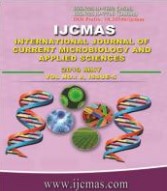


 National Academy of Agricultural Sciences (NAAS)
National Academy of Agricultural Sciences (NAAS)

|
PRINT ISSN : 2319-7692
Online ISSN : 2319-7706 Issues : 12 per year Publisher : Excellent Publishers Email : editorijcmas@gmail.com / submit@ijcmas.com Editor-in-chief: Dr.M.Prakash Index Copernicus ICV 2018: 95.39 NAAS RATING 2020: 5.38 |
The concept of balanced fertilization with proper method at proper time paves the way for optimum profitability of farmers. Since most of the soils in Koshi region of Bihar are sandy clay in their textural class with medium to low in N, P, K and Zn. Due to that farmers of Koshi region applying nutrients unscientifically. Therefore, they enable to reap best harvest and to augment the profitability from this crop and hence an experiment was conducted at farmer fields of Katihar district by Krishi Vigyan Kendra, Katihar, (Bihar Agricultural University Sabour, Bhagalpur) during two consecutive years of 2015-16 and 2016-17 to study the effect of nutrients application method on productivity and economics of maize. The experiment was laid out in alluvial soil with three treatments and ten replications in RBD. The details of treatments was {(T1–Farmer Practices (60:0: 0:: N:P:K Basal + 50:40:20 N:P:K at 30 DAS+ 30 kg N at 60 DAS), T2–RDF (60:60:40:: N:P:K Basal + 45 kg N at 30 DAS+45 kg N at 60 DAS), T3– RDF (60:60:40:25:: N:P:K:Zn Basal + 45 kg N at 30 DAS + 45 kg N at 60 DAS)}. Healthy and bold seeds of maize var. Pioneer 3522 were dibbled into the soil @ 1 seed hill-1 at a spacing of 60 cm X 20 cm. The growth and yield attributes of maize viz., plant height, plant diameter, leaf length, leaf width, cob length, no of cob per plant, no of grains per cob, kernel and stover yield were significantly influenced by different method of nutrient application. There was a progressive increase in the growth and yield attributes with each application methods of nutrients applied from T1 to T2 and further increase in growth attributes were noticed when the graded levels fertility were supplemented with Zn as soil application T3. There was a gradual and progressive increase in growth and yield attributes with basal application of P K and zinc in comparison to T1 where P K applied at 30 days after sowing.
 |
 |
 |
 |
 |